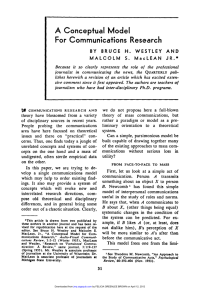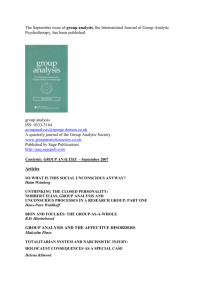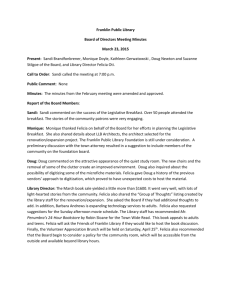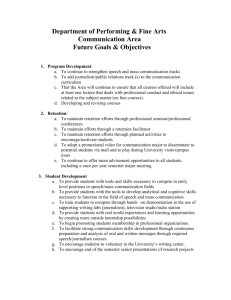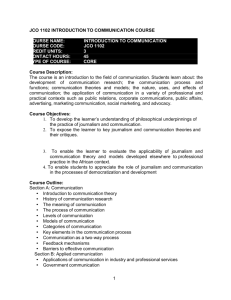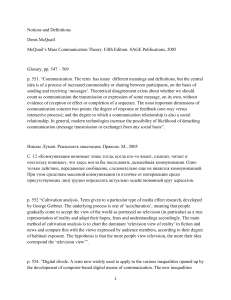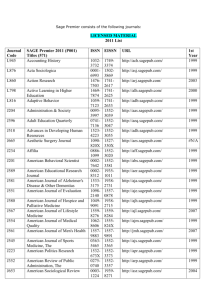defining international communication as a field
advertisement
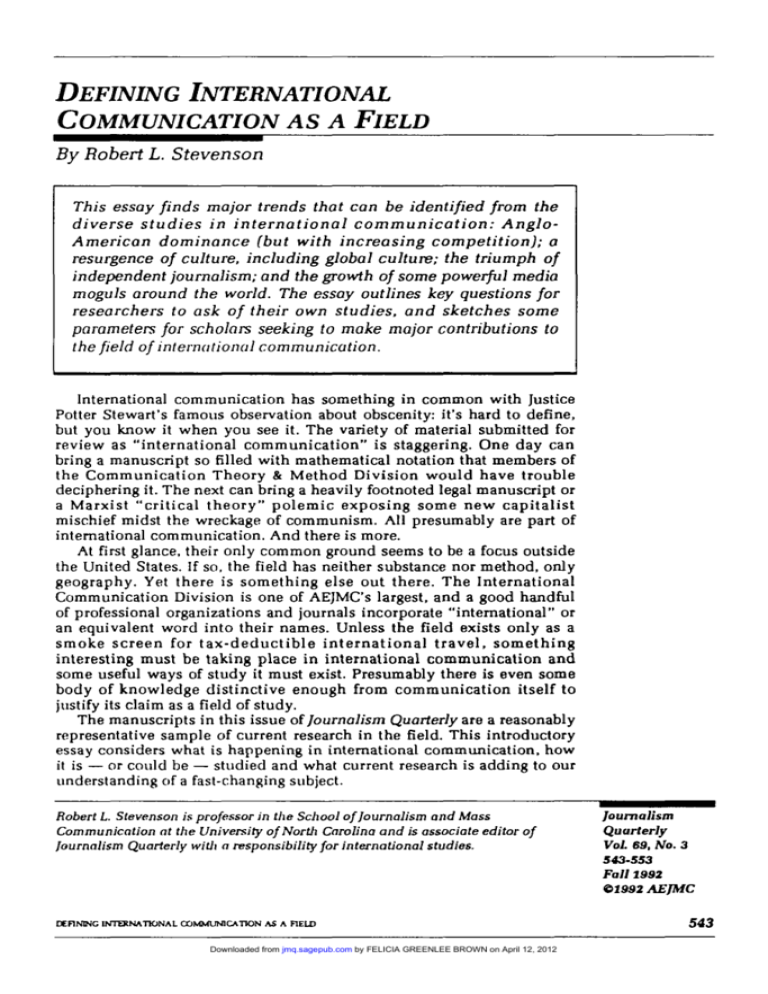
DEFINING INTERNATIONAL COMMUNICATION A S A FIELD By Robert L. Stevenson This essay finds major trends that can be identified from the diverse studies i n international communication: AngloAmerican dominance (but with increasing competition); a resurgence of culture, including global culture; the triumph of independent journalism; and the growth of some powerful media moguls around the world. The essay outlines key questions for researchers to ask of their own studies, and sketches some parameters for scholars seeking to moke major contributions to the field of internrrtional communicution. lnternational communication has something in common with Justice Potter Stewart’s famous observation about obscenity: it’s hard to define, but you know it when you see it. The variety of material submitted for review as “international communication” is staggering. One day can bring a manuscript so filled with mathematical notation that members of the Communication Theory & Method Division would have trouble deciphering it. The next can bring a heavily footnoted legal manuscript or a Marxist “critical theory” polemic exposing some new capitalist mischief midst the wreckage of communism. All presumably are part of international communication. And there is more. At first glance. their only common ground seems to be a focus outside the United States. If so, the field has neither substance nor method, only geography. Yet there is something else out there. The International Communication Division is one of AEJMC’s largest, and a good handful of professional organizations and journals incorporate “international” or an equivalent word into their names. Unless the field exists only as a smoke screen for tax-deductible international travel, something interesting must be taking place in international communication and some useful ways of study it must exist. Presumably there is even some body of knowledge distinctive enough from communication itself to justify its claim as a field of study. The manuscripts in this issue ofJournalismQuarterly are a reasonably representative sample of current research in the field. This introductory essay considers what is happening in international communication, how it is - or coiild be - studied and what current research is adding to our understanding of a fast-changing subject. Robert L. Stevenson is professor in the Scliool of Journalism and Mass Communication nt the University of Nortli Carolina and is associate editor of ]ournnlism Quarterly with n responsibility for international studies. Journalism Quurterly Vol. 69, No.3 543-553 Fall 1992 81992 AEJMC DEflNPlC “ A T K J N A L OOMMUNIUTION AS A FIEID Downloaded from jmq.sagepub.com by FELICIA GREENLEE BROWN on April 12, 2012 543 In an age of suitcase satellite telephones and global CNN, it is hard to imagine any spot on earth not touched by international communication. M u c h h a s b e e n w r i t t e n about t h e u n p r e c e d e n t e d Anglo-American d o m i n a n c e in all aspects of international communication i n recent decades. It is usually decried as some kind of “cultural imperialism” that uses multinational information industries as a replacement for t h e colonial armies of t h e 18th and 19th centuries. Almost as much has been written in the past year about the technological innovations that brought the Gulf War live to the world and about the new generation of marvels that lie o n the horizon. Global lkends in Communication T h e s e are facets of a broader picture. There are various ways of organizing the details, but it may be useful to think of five global trends in international communication. 1 . Anglo-American Dominance. T h e phenomenon of an emerging global culture that looks like it was created in Hollywood, New York and London is t h e s o u r c e of a great deal of t h e “cultural imperialism” argument. I t is not infrequently invoked at international academic conferences by delegates wearing Levi’s, smoking Marlboros and drinking Coke, of course. This dominance has several facets, which can be grouped into four main areas. a. Language. Estimates of the number of people around the world who know at least some English vary from about one in six to one in three.* More people in Russia and China are studying English than speak it as a native language. The frequency with which world leaders give interviews and protesters paint signs in English is an indication of its utility in a global culture. English h a s g o n e from t h e language of British colonialism a n d American post-war hegemony to a third stage, independent of either of its roots. I t is now the universal language of international politics, science, computers and air traffic control a s well as tourism, business and pop music. Until it fragments into a family of languages similar to t h e Romance or Slavic families, it will belong to the world. b. News. No part of AngleAmerican dominance is as visible as news, o r as contentious. Most students can come u p with the names of the big four news agencies - AP, UPI, Reuters and AFP - but few recognize the news film counterparts of Visnews. Worldwide Television News and CBS International. CNN, of course, is a global fixture as are the International Hemld Tribune. international editions of the Wall Stleet Journal, Time, Newsweek and the Economist. In most parts of the world, the BBC World Service and the Voice of America are a n important part of the media mix; in some, they are the major sources of information. For the record, it can be noted that all of the media listed here are Western and all except AFP are Anglo-American. T h e collapse of communism a n d failure of the concept of “development journalism” left t h e world with t w o media philosophies: old-fashioned authoritarianism (still very much in use) and Western. which is essentially AngleAmerican. The one in three figure is from the Universal Almanac 1991, p. 306; the one in six is from Robert McCrum, William Cran and Robert MacNeil. The Sfory ofEnglish (New York: Viking Penguin, 1006). p. 10. Downloaded from jmq.sagepub.com by FELICIA GREENLEE BROWN on April 12, 2012 For details of this aspect of global dominance and some of the fire and fury that surrounded debates about its cause, impact and resolution, the reader is advised to punch “New World Information Order” or “New World Information and Communication Order” into any academic or news data base.2 The result will be a bookshelf of material, covering roughly the 1970s but extending into the 1980s with detours t o t h e withdrawal of the United States and Britain from the United Nations Educational. Scientific a n d Cultural Organization (UNESCO) a n d a renewal of interest i n communication a n d development albeit with telecommunication rather than mass media as the focus3 c. Pop Culture. It might be a tossup between news and pop culture if one wanted to know what aspect of Anglo-American dominance gets more people angrier faster. Among politicians of the world, it is probably news, but among intellectuals and academics, it is surely pop culture. Consider the uproar over Euro Disneyland, the European Community’s determination to rid itself of an excess of Hollywood T V imports and the mileage politicians (or academics) can get out of labeling anything they don’t like as “cultural imperialism.” I t is i r o n i c t h a t a s real A n g l o - A m e r i c a n p o w e r i n t h e w o r l d diminishes, its i n f l u m c e in pop culture continues to climb. T h e best popular description of this phenomenon is Anglo-Indian-American journalist Pic0 Iyer’s tour cif Asian capitals4 Whatever our beliefs about its origins and implications, we ought to be sensitive t o t h e unique situation that allows Anglo-Americans to travel the world in a cocoon of familiar language. news and culture. d. Technology. While most of the innovation in consumer electronics now comes from Asia, the satellites and computers that make the global village possible are still created in the United States, and the electronic playthings are created with the media-saturated English-speaking markets in m i n d . “Fast Forward” a n d “Read-Only Memory” a r e part of t h e universal vocabulary. The unexpected demonstration nf digital high-definition television over existing channels in the spring of 1992 offers the possibility for the llnited States to re-establish its dominance in consumer electronics over Japan and the Europeans. as well as the chance to see another Yankee invention lost in the practical application stage through short-sighted c o r p o r a t e policy a n d t h e lack of a n y g o v e r n m e n t policy. S i m i l a r outcomes are possible for a new generation of portable, satellite-based, global telecommunication. messaging and navigation systems. 2 . Resurgence of Culture. I t is ironic that the first product of the end of the cold war is an explosion of ancient ethnic animosities, the cultural conflicts that for generations have separated “ u s ” from “ t h e m . ” A melancholy list of cultural flash points includes most parts of the world, even Western Europe. where language rather than religion or race is the focus of assertinn of cultural independence in Wales, Belgium, Spain, even the European Community itself. In our own part of the world, there My r~corrimeiitlatioiifor a11 overview is William A. Hachteii. The World News Prism, 3d ad. (Arnes, Iowa. Iowa Stale University Prrm, 1002). A point I developed in Coriiniiiiucnlion.Developnienl, orid flie Third World; the Glohal Polilics oflrifornioljoii [New York: Longman, 10OU). Pic0 lyer. Video Niglir I J I h ” ~ l h ~ ~ ~[New ~ i ~ i York: d i i Knopf, IOUU). Downloaded from jmq.sagepub.com by FELICIA GREENLEE BROWN on April 12, 2012 is the possibility of the disintegration of Canada over separate identity of Quebec and the various battles over multiculturalism and English as the official language in the United States. This does not seem to be what Francis Fukuyama had in mind when he (citing Hegel as his authority) proclaimed the end of history.5 Nor is it much of a dividend from the collapse of communism. 3. A Glohnl Culture. It is a curious counterpart to the resurgence of cultural conflict around the world that simultaneously the outline of a global culture is emerging. The bad side of the global culture is that it is relentlessly commercial, superficial a n d possibly threatening to real culture. T h e Canadians worried enough to exclude cultural industries from t h e free trade agreement with t h e United States. T h e European Community - hardly part of the cultural imperialism cabal - wants to protect t h e Italians and Dutch from too m u c h exposure to mindless Hollywood programming o n t h e d u b i o u s assumption that mindless British, French and German programming is acceptable. The good side of a global culture is that it is truly global, despite a patina of Anglo-American glitz a n d t h e inevitable English language. Another possible advantage is that it may be the only alternative to neverending cultural conflict. Sending the Serbs, Croats and Bosnians to Euro Disneyland or supplying them with “Rambo” tapes might not end the fighting, but nothing else has worked. It’s worth a try. 4 . Triumph of Independent Journalism.T h e most d r a m a t i c a n d immediate victor in the collapse of communism was the Western media. No o n e had anticipated t h e speed a n d intensity with which the communist media systems - all fashioned according to Lenin’s model of propaganda, agitation and control - would be attacked and discarded or the influence of Western media. Pravda went bust, and Radio Moscow sold its jamming transmitters to Western broadcasters. VOA became the most popular station in Sophia and indispensable in China. Gorbachev spent his short captivity during the failed coup listening to Western short wave stations. Development journalism, which w a s advanced as a n appropriate alternative to Western and communist media theories, suffered the same fate. The Non-Aligned News Agencies (NANA) pool headquartered in Yugoslavia and the Pan-African News Agency (PANA) - both models of development journalism - were never successful and entered the 1990s universally ignored and perpetually on the verge of collapse. In the Third World. as in the rubble of communism, people turned to Western media for information and models for the future. Even the most optimistic assessments of the future would not exclude government efforts to influence the media i n the West or government control of the media in other parts of the world, but the legitimacy of government control is gone. The proliferation of faxes, e-mail, DBS TV, desktop publishing a n d VCRs means that a government monopoly on information - never successful anyway - is no longer a realistic policy. The main question for Fukuyama’s post-history is whether glasnost precedes perestroika or follows it, the 1990s formulation of the question rif the linkages between democracy and economic growth. Middle Europe j Francis Fukuyama, The End ofHJsfory and fhe Lad Man (New York: Free Press, 101)2), c!xpantIing h i s prescient essay. “The End of History?” in the Public Inferesf, 16 (Suininer. 1089),3-1&. Downloaded from jmq.sagepub.com by FELICIA GREENLEE BROWN on April 12, 2012 chose to e m p h a s i z e democracy, hoping i t w o u l d lead t o economic growth, while the tigers of Asia put an emphasis on economic growth with full democracy pushed into the future. The record to date suggests that the perestroika first-then glasnost (maybe) i n Asia outperformed glasnost n o w - p e r e s t r o i k a l a t e r ( w i t h l u c k ) i n Europe. T h e global experiment will be an important case study for the subset of international c o m m u n i c a t i o n devoted t o t h e role of c o m m u n i c a t i o n i n national development. 5. New Media Moguls.6 The growth of global communication systems has been accompanied by the emergence of a new generation of media moguls who share some characteristics of the older generation of Hearst and Pulitzer, but not all. Many of them are relatively unknown and, perhaps surprisingly, given the dominance of Anglo-America in global communication. several of the most important come from outside t h e Eng 1ish-s p ea ki ng wor I d. Rupert Murdoch. Australian born but now a US. citizen, is the best known of this breed. With operations in various media from Australia across the South Pacific (including papers i n Fiji and Hong Kong) to Britain (both the Sun and Tirries and the only DBS TV system) and North America (TV Guide, the Fox studios a n d network, and several major newspapers quickly bought a n d sold), h e is highly visible, openly partisan and at home astride the global arc of Anglo-American influence. O n l y t h e l a t e Robert M a x w e l l c o u l d c o m p e t e f o r H e a r s t - s t y l e flamboyance and partisanship. Most A m e r i c a n s k n o w l i t t l e a b o u t t h e s e t w o bigger-than-life characters and virtually nothing about others from non-English-speaking countries. The list of modern moguls includes several who are powerful political partisans at h o m e (Hersant a n d Lagardere in France, t h e Springer house in Germany, Berlusconi i n Italy. Marinho i n Brazil, O'Farrill in Mexico) and others who are virtually recluses even at home (Kirch a n d t h e Bertelsmann o r g a n i z a t i o n i n Germany). S o m e a r e conglomerates without a dynamic leader, and almost all have some ties to the fountainhead of the global culture, the United States. From an American perspective, a growing concern is not our real or imagined use of information and culture to maintain global influence but the speed with which we are selling off our popular culture industries. T h e reason i s not hard to find: if you were a foreign company with several billion dollars piled up from an intractable trade deficit, what would you buy, General Motors or a Hollywood studio? After t h e p u b l i c i t y s u r r o u n d i n g t h e i r s a l e s . a fair n u m b e r of Americans probably know that four of the seven top Hollywood studios are foreign owned (two by Japanese. one by an Italian, and Fox, which is owned by Murtloch's Australia-based News Corp.). About as many pro1)al)ly know that CBS Records is owned by Sony but few realize that a German cc~nipany.Bertelsiiiann, is the largest publisher of books in the United States antl B major player in other media, including records and printing. See Jeremy Tunstall antl Michael Palmer, Media Moguls (London: Routledge, 19911; Ben H. Bagdikian. "The Lords of the Global Village," The Nation, 248. No. 23 [June 12. 1080), pp. 805-820; William Fisher and Mark Schapiro, "Four Titans Carve Up EiiropHan TV." The Notion. 240, No. 2 (Jan.9-16, 1080). pp. 52-58. DEflMNC INTERNATIONAL COMMIIMCATlON AS A nELn Downloaded from jmq.sagepub.com by FELICIA GREENLEE BROWN on April 12, 2012 54 7 Other major foreign owners include the Canadian Thomson chain with more than 100 (mostly small) daily newspapers, the Middle East o w n e r s h i p of the apparently doomed UP1 and several European conglomerates snapping up magazines. In the opposite direction, of course, is CNN - truly the world’s most important network - and the commercial networks whose news operations may be merged with global film agencies (NBC with Visnews, ABC with WTN, CBS with TBS in Japan). In news, if not in popular culture, American dominance seems secure. Somehow we need to make sense out of this kaleidoscope of change. Studying z&!rnatjond Communication How to organize a vast, amorphous body of research that shares neither common method nor agreed-on substance? Is it even possible to find commonalities in an undefined field that overlaps every AEJMC division? Perhaps not, but the following outline can serve as a starting point for organization of the field and for a critique of existing research. Some years ago, William Paisley proposed a two-dimensional matrix placing the s t u d y of mass communication within the context of traditional and emerging disciplines.’ He first defined communication as cine of the elementary behavior-defined disciplines such as cybernetics and systems analysis that served as elements of other, more general disciplines such as education (learning), economics (value) and political science (power). He noted that many of these disciplines were relatively new and sometimes undefined. The orthogonal dimension comprised disciplines defined by their unit of analysis, ranging from atom and molecule (natural sciences] through cell and subsystem (biological sciences) and then to individual, group and culture (social sciences). Thus, one studies some behavior at some unit of analysis. While theoretically cine could study any behavior at any level of analysis feedback systems of cultures. distribution of power among living cells most disciplines specialize. Although the differences are blurred, American communication studies traditionally concentrate on the individual and group (with emphasis on data analysis), while Europeans usually focus on national and global levels of analysis (with little emphasis on empirical test). Most of the research in international communication uses a relatively large unit of analysis, typically a national media system or culture. Sometimes individual behavior nested within a nation or culture is the basis for cross-cultural studies. A third dimension added to this matrix both defines the minimum criterion for i n c l u s i o n i n “ i n t e r n a t i o n a l c o m m u n i c a t i o n ” a n d distinguishes its four subsets. Foreign studies are single-country or single-culture studies that are usually heavy on description and light on explanation. Comparative studies contrast communication behavior of individuals or institutions within one culture or nation with equivalent hehavior in another, usually with some element of the nation or culture as the basis for explanation of differences. International and intercultural studies consider the flow of information and influences from one nation or culture to another. Global studies, often associated with sweeping ’Williairi Paisley. Research a Behavioral Discipline (Stanford, Calif.: Communication Research. Stanford University, Institute Coo~n~irnication as for Downloaded from jmq.sagepub.com by FELICIA GREENLEE BROWN on April 12, 2012 1972). theories of global hegemony, of course, see the entire planet as a unified system. These three dimensions form a cube whose sides define the field of international communication in terms of (1) a focal variable, which is some aspect of communication, ( 2 ) a unit of analysis that can range from the individual to the entire globe, and (3) the delineation of national or c u l t u r a l b o u n d a r i e s t h a t , in m o s t s t u d i e s , p r o v i d e t h e b a s i s f o r comparison or explanation. A schema such as this is neither unique nor all-encompassing. For one thing, it does not distinguish between culture and nation, although the usual definitions c a n be invoked a s necessary. A nation i s a n independent political entity that is identified by a flag, airline and seat at the United Nations, if nothing else, while a culture is more amorphous but usually more persistent. The traditional definition is that a culture includes the behaviors and values, derived from a common history, that unite one group of people and separate them from others. Scholars can debate whether culture o r nation is a more useful unit for research, but nation probably gets t h e edge i n m a s s m e d i a s t u d i e s s i n c e media institutions are usually linked to the national political system. In other disciplines. particularly where one wants to explain individual differences as products of cultural values and experience, cultural studies may dominate. Obviously every nation is-so to speak-multicultural, a point that i s brought h o m e almost daily i n news reports of cultural conflict and assertion of cultural independence. The literature is full of references to cross, inter and comparative as criteria for separating the field from other specialties that find an outlet in Journalism Quarterly.8 The distinctions are more important than the labels. As a general rule, any study that invokes nation or culture as the basis of explanation needs a second data point in another nation or culture to demonstrate concomitant variation. Without it, any explanation becomes equally tenable. The cultural imperialists are often vulnerable o n this point. They array their evidence to attack the media i n W e s t e r n c a p i t a l i s t n a t i o n s b u t fail t o d e m o n s t r a t e t h a t p e o p l e , governments or media are any different in non-capitalist, non-Western countries. Usually they are the same or worse.9 Despite confusion over theory and method, the output of international communication research is enormous as well as disparate. Some systematic way needs to be found to assess it. Even o n t h e basis of volume, international c o m m u n i c a t i o n i s a growing field. Although o v e r s h a d o w e d i n n u m b e r s i n AEJMC a n d ~~~~~~j~~ the Field See Alex S Edelstrin, Youirhi lto antl Hans Mathias Kepplinger. Communication 6 Culrun; o Coaipam/ive Appiworh (White Plains, N . Y . : Longman, 1989).for e similar approach antl summary of alternative specifications. This is one of the few works to define the field and discuss the theoretical and methodological implications. I) The theoretical importance of the uniformily of media content across a wide range of political and economic systems is developed in my “A Critical Look at Critical Analysis.” journal of Conmimicotion, 33(3):262-260 (Summer, 1083).This important finding is documented in e large study of foreign news in Ihe late 1970s (Annabelle Sreberny-Mohammadi, et al., Foreign News in the Media: International Repoding in Twenty-Nine Countries (Parin: UNESCO, lS851l end recently in the largest study of nationel news around the world to date. See InterMedia, published by the International Institute of Communications. London, Vol. 20, Nos. 1 and 2 (Jan.-Feb. and March-April, 1002), which are devoted to the study. (1 UZRMNC IN’lWlNATIONAL COMWJXlCATION AS A FlEU) Downloaded from jmq.sagepub.com by FELICIA GREENLEE BROWN on April 12, 2012 549 journalism Quarterly by several other specialties, the field can claim the International Communication Association, the International Association for Mass Communication Research and regional organizations around the world. It overlaps the International Studies Association and dozens of discipline-defined a n d area studies organizations. The list of journals published in the United States is long and diverse. Every region of the world has a least one academic organization and journal as well so that the conscientious scholar needs both foreign language skills and a hefty bank account. Achieving quality is a c h a l l e n g e i n a n y field but especially i n international communication, which lacks a common focal variable. method and literature. There may be some comfort - but not much - to k n o w t h a t JQ associate e d i t o r s o f t e n confront t h e problem of low reliability of manuscript evaluations. “Brilliant a n d groundbreaking! Publish at once!” says o n e reviewer. “Pure dreck! An insult to t h e reader!” says another, about the same manuscript. A roll of the dice is one way to select the one manuscript in five or six that gets accepted, but we’d like to think that a rational process of critique can d o better. It can, and usually does. At o n e l e v e l , a l l m e t h o d s of r e s e a r c h s h a r e a c o m m o n s e t of reqiiirements. T h e y are reliability a n d validity of observation a n d adequacy of evidence. International communication, lacking a common method as well as body of knowledge, seems more prone than most of its companion fields toward disagreement over what is good - o r even minimally competent - research. The old fight between “administrative” and “critical” research reaches the flash point when ideology poses as theory and polemic as research. By polemic, I mean starting with the conclusion and assembling evidence t o support it. Polemic is fine in a courtroom or debating chamber, but what distinguishes academic research from polemic is the uncertainty of the riutcome. I expect my defense lawyer to make the best possible case for my innocence, but even my most brilliant scholarly insight may fail for lack of logic or evidence. A special edition of Journalism Quarterly might usefully be devoted to clever research ideas that failed the test of empirical verification. If nothing else, we would have a n inventory of factors that d o not influence mass media and are not influenced by them, something akin tci Etlison’s large collection of unsuccessful light bulb filaments. Positivism is out of favor these days, but there is something satisfying a n d p e r s u a s i v e a b o u t a research i d e a that is fully e x p l i c a t e d a n d supported by properly executed empirical test. Such studies are rare. Research in international communication too often relies on citation of a handful of key ideas - as if enough repetition of an idea makes it true and fashion. In some cases, it approaches political correctness. Occasionally - notably in t h e “critical” school - polemic masquerading as scholarship reaches absurdity. A popular assertion in the NWlO debate was that the Western news agencies “devote only 20 to 30 percent of news coverage to the developing countries, des ite the fact that the latter account for almost three-quarters of mankind.”& Ignore for l o Mustapha Masmoudi. “The N e w World Information Order,” journal of C O J J l m I J i C I 2 ~ i O n 20(2):172-173 . (Spring 1070). 550 JOORNAUSM QuIv1nmy Downloaded from jmq.sagepub.com by FELICIA GREENLEE BROWN on April 12, 2012 the moment t h e implication that, since everyone in the world is equally considered newsworthy, more than 40% of the news in every country should come from China and India or that news flow between the United States and Canada should be ten times i n favor of the United States, about what it is. M a s m o u d i d o e s not give a s o u r c e , b u t c o m p a r a b l e s t a t e m e n t s occasionally acknowledge studies of state domestic wire service files that are a world apart from the international regional services or computer files that most American papers now receive. A similar approach was taken in a recent paper that decried the lack of foreign news in U.S. media based o n a content analysis of the late-evening local news i n two small TV markets. Such polemic masquerading a s research does not qualify as sophistry. It is merely silly. It should be noted that “empirical” does not mean “quantitative.” Some of the most insightful studies of international communication are qualitative research by scholars whose authority is a product of longtime immersion in antl sensitive observation of their own or other cultures. It dries mean. hciwevcr. that all scholars need to ask themselves frequently. “Am I describing what I think I am?“ (validity). “Would others interpret this differently?” (relinhility). “Am 1 lnnving srimething out?” (adequacy (if evidence). As noted earlier. research in international communication should not pit “critical” v s . ” a d m i n i s t r a t i v e ” s c h o l a r s h i p or, for that m a t t e r , qualitative vs. quantitative or historical method vs. social science. The big issue is research vs. polemic. T o separate one from the other - and to evaluate manuscripts fairly that cover every conceivable topic, method and content, four questions can be asked of any piece of research.ll The interrogatives themselves are harsh but could enliven a n occasional session at AEJMC. The purpose they serve in evaluating any piece of research is important, however. especially when one gets beyond t h e technical aspects of research design and the basic questions of validity, reliability and atlequacy of evidence. W h n t ? (Description). T o o often m a n u s c r i p t s c o n t a i n t h e w o r d s “exploratory study” or a sentence to the effect that the author’s goal is merely to describe some interesting phenomenon. They are frequently found in content analysis projects, but historian colleagues also complain of a glut of biographies of not-so-famous journalists that are devoid of anything beyond a simple chronicle of their lives and newspapers. D e s c r i p t i o n by i t s e l f c a n b e u s e f u l , b u t too o f t e n t h e p h r a s e “exploratory study” means the author didn’t take the time to anticipate findings. test the logical conclusion of an implicit theory and link his or her study to other research. The result is a study whose ultimate value depends on t h e ability of someone else to integrate it into a broader perspective. Otherwise. it will remain isolated from the general body of knowledge of the field. unread and uncitt?tl. Exceptirins exist: descriptive studies of media systems in countries we s e l d o m h e a r a b o u t . a l t e r n a t i v e d e f i n i t i o n s of p r e s s f r e e d o m a n d The two middle questions come from Richard F. Carter a t the University of Washington. Since my graduate school days there, a recurring nightmare is that h e would pose them to me at some public presentation of my research. The others are the product of reeding seminar papers antl viewing manuscripts submitted to various joiinials and ~ o n f e r e i i c ~ ~ . DEflNINC IPmRNATlONAL CUWIMCATION AS A f l E U ) Downloaded from jmq.sagepub.com by FELICIA GREENLEE BROWN on April 12, 2012 552 responsibility, among others. Even these, however, become meaningful when an implicit comparison with other countries is made explicit. A rule of thumb is that if the words “exploratory” or “descriptive” appears in the first few paragraphs, the author is lazy or the study isn’t worth mirch Why? (Explanation). Almost any purely descriptive study can be made more valuable by adding the word “because” to the key findings. Most of us have scribbled “Why?” in the margin of dozens of seminar papers, adding bolder question marks and multiple exclamation points as our frustration grows. It is probably a product of our system of graduate e d u c a t i o n that few s t u d e n t s present real theses - bold, even controversial conclusions they are willing to defend through logic and evidence. The situation is similar among manuscripts submitted to Journolism Quarterly. On one hand, there are the relatively few polemics with fury but little evidence; on the other, there are the many that document interesting facets of the field but offer no explanation. Even the null hypotheses can be interesting. Why are media systems s o similar around the world, despite great differences in ownership, control. organization and purpose? Why did the great campaigns to use mass media to change behavioral patterns fail in both communist coitntries and Third World development programs? Why is culture so persistent, even when it is clearly destructive to itself and others? We are appropriately cautious about using the word “cause,” but conservatism in claiming knowledge should not let u s avoid explanation. Look for “because” in any research paper, especially in the introduction. Then the reader can follow the argument and evidence to see if the description jmtifies the explanation that comes at the end of the manuscript. A sentence in the first paragraph with the phrase, “A causes B because C” may lack literary style but is a valuable road map for writer, reviewer and reader. Even better. put it in the title. After obligatory cute phrase in front of the colon, insist on something like, “The Influence of X on Y” or “ A as a Factor in the B of C.” I t informs the reader and forces precise thinking. So Whot? (Implication). The temptation arises frequently at the end of conference sessions to raise one’s hand and ask, “So what?” Usually politeness and the lure of the coffee shop are stronger. The question can be rephrased: Now that we know that, how is our understanding of international communication expanded? Sometimes the fault is lack of adequate hypotheses. Usually we start with the familiar “if X. then Y: not Y: therefore not X” formulation. A more complete formulation begins, “ I f X leads to Y, then Z.” The Z represents both the logical implications of the simple formulation that ought to be the basis of the specific observation and the practical implication of the broader questions inherent in the study. If the New York Tinies and the Times of London (or, for that matter, the People’s Doily) cover an event differently. what does that tell us? That media operate within and reflect their national political systems? That the concept of objectivity is a fraud? That reporting is influenced by A corollary applies to method. If the method appears in the title, the purpose of the study was probably to see if a specific method could be applied to a particular research problem. The answer is that it usually a n . although rarely with useful rr-.ults. 55 2 ]ouANAUSM Downloaded from jmq.sagepub.com by FELICIA GREENLEE BROWN on April 12, 2012 QUMRRL Y ownership? Or merely that different reporters in different places at different times with different sources come u p with different stories? All of these explanations may be true, but so what? Who Cares? (Importance). In theory, every individual, every culture, every nation has something to teach us. But i n news as in politics a n d sports, there is a bias in favor of t h e big, the important and the powerful. The same is true of research. Realistically, not every research question is equally important, and not every research setting is equally informative. For most purposes, t h e New York Times is more important t h a n t h e Tirnes of Zambia. and a study of the role of mass media in the collapse of communism in 1989 is more informative than a study of the role of media in the collapse of the government of Liechtenstein. But not always. The less familiar setting, the less prominent medium o r state can often provide t h e off-diagonal exception to t h e general principle. How d o some cultures maintain integrity and identity against the tide of influence from the West? How d o some cultures maintain diversity of media voices and press freedom without reliance o n t h e equivalent of the First Amendment? Good theory is protection against both the So what? and Who cares? questions. Facts come and go, but theory remains. Probably n o one at this point remembers whether the U.S. Army training films i n World War I1 were effective or ineffective (or even what they were about), but we all know some of t h e principles of persuasion that came out of the Yale project. Certainly no one remembers what public issues were o n t h e agenda in Chapel Hill in 1968, hiit the agenda-setting theory, as they say, is history. Think theiiry tu avoid this question. The manuscripts that follow were not commissioned for this special issue or pulled from the queue of manuscripts awailing publicalion for it. They represent a snapshot of research in the field now and have survived t h e review process that accepts less t h a n o n e i n four m a n u s c r i p t s submitted toJQ. Readers are invited to use them to assess the field in two ways. One is to see how the field is defined, using t h e three-dimensional matrix introduced above. The other is to evaluate their contributions to a distinct sub-discipline of international communication by applying the four questions. On the whole, JQ articles stand up well. They are the best of a field that is vigorous. contentious and growing i n importance. Research i n international communication in the early 19E)Os, it turns out, is a lot like international communication itself. In a dynamic field, how could it be otherwise? IEFINLNC INTERSATKJNAL CXJMMLNL\llUN .LS A FlELD Downloaded from jmq.sagepub.com by FELICIA GREENLEE BROWN on April 12, 2012 553
